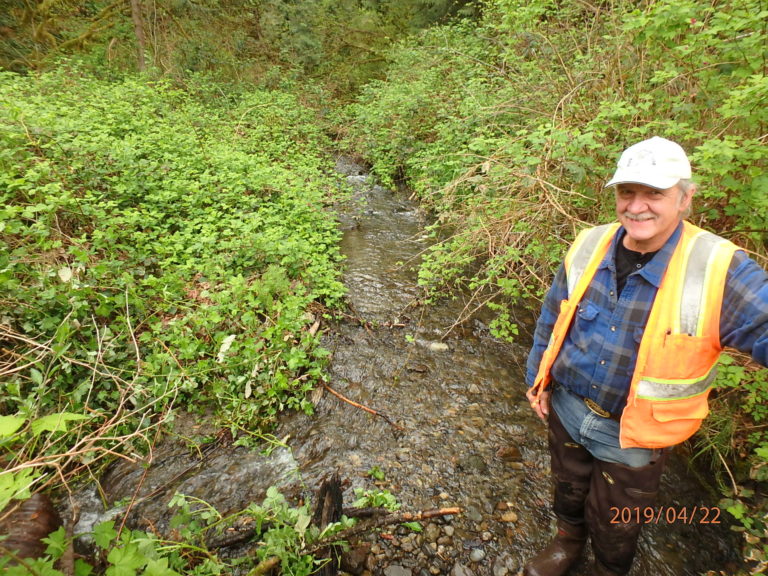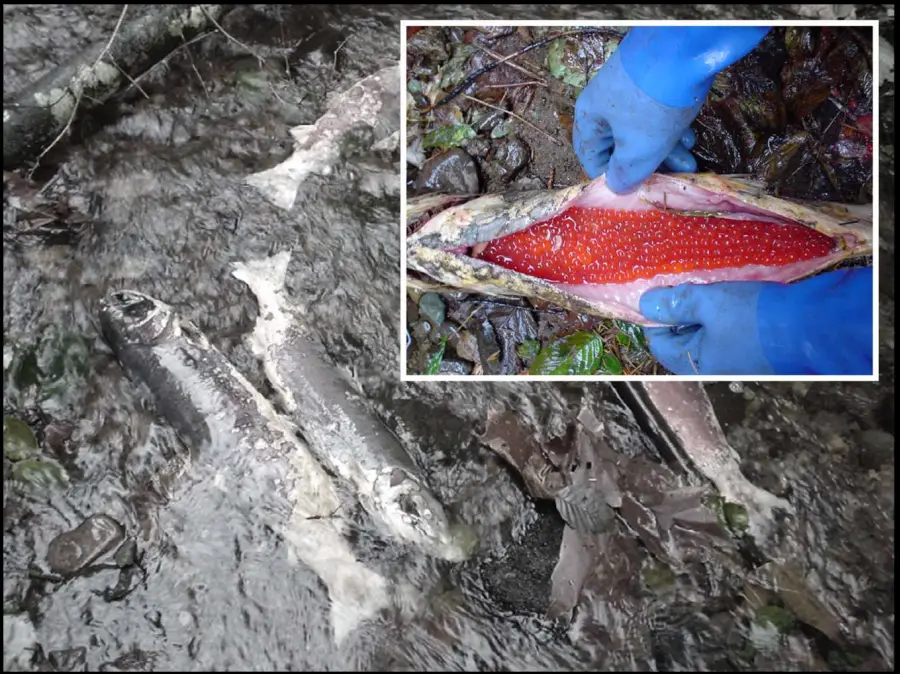

Pre-spawn mortality (PSM) is an emerging toxicity issue impacting Puget Sound watersheds. Where it occurs, adult salmon returning to freshwater die before they are able to spawn completely. The cause of PSM was identified as toxic road runoff associated with chemicals leaching out of automobile ‘tire dust’ which wears off tires during the normal wear and tear of driving.
Wild Fish Conservancy completed weekly spawning surveys of channels in Whatcom, King, and Thurston Counties, in western Washington State, with annual fall coho runs of 10 or more individuals and which represent a range in road density and stormwater inputs.
To supplement the field data, Wild Fish Conservancy distributed a survey to State and local governments, Tribes, and select conservation non-profits inquiring about local salmon spawning efforts and potential PSM occurrences.
During the course of the field surveys, the riparian area was carefully inspected for signs of carcasses dragged to shore by animals such as otters, dogs, raccoons, bears, opossums and coyotes. Crews were also vigilant for the wafting odor of a rotting carcass, prompting a heightened search in those areas.
Spawning success was determined by examining female carcass gonads. The eggs of females are contained within two separate skeins within the body cavity. If these skeins appeared equal in size, full, firm, and intact, the fish was considered un-spawned. If eggs were retained by the fish, they were counted. When counting was impractical, the volume of eggs retained was measured in a beaker, and the diameter of five randomly chosen eggs was measured to estimate the average egg diameter. With these two values the estimated number of eggs in the fish could be calculated. Females with more than 75% of the eggs were retained the fish exhibited PSM. The spawning success of significantly scavenged fish were included in analysis because they were either too difficult or too subjective to evaluate in the field.
While no statistical relationship was found between the percentage of carcasses with PSM and the land use of the location where the fish was found, the majority of the land use in sites sampled had greater than 10% impervious cover and many PSM sample sizes were too small to allow for more robust analysis. From the surveys Wild Fish Conservancy confirmed PSM in 37% of responses. In cases when PSM reported in surveys was not confirmed the cause of fish death was identified as stranding, disease, stress from warm waters, poaching, lack of passage at culverts/dams, and/or low water conditions. It is recommended that this study be continued to refine the estimates of PSM and better document the extend to the phenomenon.
Location | Start Date |
|---|---|
Whatcom, King, and Thurston Counties, Western Washington State | 09/27/2005 |
Project Type | Completion Date |
|---|---|
Spawning Survey | 01/25/2006 |
To identify occurrences of pre-spawn mortality in coho populations both spatially and temporally.
To identify the relationship between land use and occurrences of both pre-spawn mortality.
To Identify coarse-scale GIS aspects of watersheds with PSM occurrences.
To reach out to State and local governments, Tribes, and select conservation non-profits inquiring about local salmon spawning efforts and potential PSM occurrences to collect more extensive information on the geographic extent of coho PSM and to educate managers and spread awareness of the phenomenon.
To use this information to help in identifying and prioritizing locations where improving stormwater infrastructure will prevent continual damage to biota in streams.
Primary Habitats Impacted By Project: | Managing Agency/ Organization: |
|---|---|
Rural and Urban Riparian Channels | Wild Fish Conservancy |
Project Contact: | Budget or Project Cost: |
|---|---|
Jamie Glasgow |
Funding Sources: | Partners: |
|---|---|
Environmental Protection Agency |
Join our mailing list to recieve important updates on our work, the latest wild fish news, & opportunities to take action to support wild fish.
This site is protected by reCAPTCHA and the Google Privacy Policy and Terms of Service apply.
Wild Fish Conservancy is recognized as a 501(c)3 non-profit by the IRS